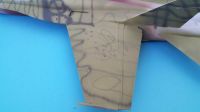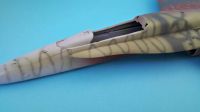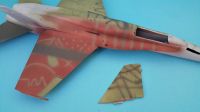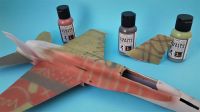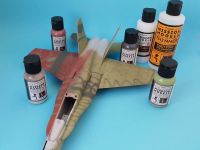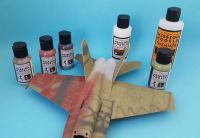Mission Models | Acrylic Paints
Reviewed by Mitko Nikitov
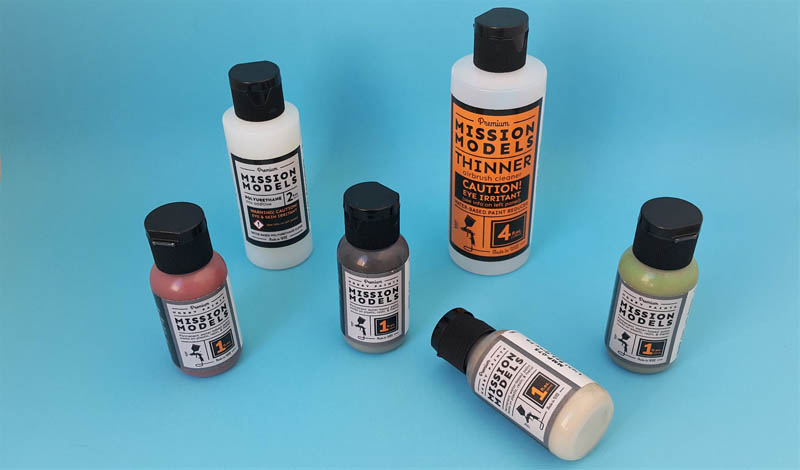
Lately it is hard to spot something new on the modeling market scene. We witness duplicating subjects, almost equal tools, often repacked and re-branded and 99% of this comes from China. It is some sort of a magical circle, with no end and repetitive events, in which we dwell. For a long time, change is needed, to stir the things up and boost the creativity among competitors, simultaneously benefiting the modelers and the hobby all together.
A company that makes their products in Utah, U.S.A. came to the spotlight and they have to offer something new and radically different. I know, most of you will raise their eyebrows at this point but bear with me for a while and you will see that the difference between Mission Models and the rest is substantial.
The Paints
Mission Models have a relatively wide number of colors, despite being newcomer in the business. They do appear in a very tough moment for making money, with well accepted and established brands like Tamiya and Mr. Hobby and the numerous variations of a slightly different concept, presented by Vallejo, MIG, AK-Interactive and their many variations. The only company that appeared around the same time was Mr. Paint but their concept is very different. Mission Models offer acrylics, which were inspired and built around the idea of safest work environment possible, combined with economically sound package and paint distribution.
The bottles are 1 oz in size and they can be bought for about $6 per piece, depending on your source. Bottles do feature dropper which is embedded in the screw cap, beneath which the bottle is sealed just like a medicine syrup. That guarantees that you are getting a product which will begin its shelf life after you break the seal, not when it leaves the factory.
Inside of the 1oz bottle, Mission models installed a shaking ball for mixing the paint properly and prep the pigment in the most adequate way before spraying. The state of the liquid allows for straight-out-of-the-bottle usage, however Mission Models do recommend their thinner for reaching the best possible quality of the medium. It comes in 2 and 4oz bottles and is a two in one solution. That means that is not only a thinner but also an airbrush cleaner. Packed in the very similar to the paints manner, the bottles feature transparent liquid, which will enhance your paint airbrushing qualities, and help afterwards when shooting plain thinner through your airbrush for cleaning purposes. As we all know, when you add part of the cleaner as a thinner, flushing the airbrush is always easier. I bet you all have done it with Tamiya paints and IPA.
Polyurethane that mission models offers is an additive to the mix mentioned above. This is an optional solution, for those who want to achieve eggshell appearance and add strength to their paints. It alters the final look slightly and can be used with certain colors for better realism. This of course is just an example. You can use it with all your Mission Models’ paints as well as with none of them.
Guidelines
Mission Models are the only company that I came across, which gave specific and thorough instructions on what to do and what to avoid, while working with their product. For example, thinning can be done with distilled water, but never with tap water.
How to use Poly and what results you should expect and never to mix the paints with IPA or glass cleaner for example. This is clearly described in the leaflet I received with my paints as well as on a small cardboard piece, dedicated solely for the purpose of being a guideline. Being a step aside from the path well known, this is important so to let you adapt to the new way of using paints and to spare you the hassle of inventing the wheel once more.
Results
Overall results that Mission Model paints give are very satisfactory. They do appear thicker than the ones we are used to. Low-fat milk doesn’t apply to them. Here we have slightly intimidating appearance in the cup of the airbrush, but they do spray quite well.
One thing important about them is that different colors might appear different in their consistency. They will spray equally easy though.
Being thicker, besides being a bit scary when you use them for a first time is cost effective. In reality, you use less liquid to cover the same area.
Elasticity that finish gives is also one to praise. Especially nowadays, when models are full with moving parts, different mediums and what not.
Color-wise, Mission Models have some room to fill, but being relatively new on the market they do not disappoint.
Below is a short video I made about testing the Mission Models thinner and paint:
Conclusion
It very easy for me to conclude. Those paints work perfectly for me. The main reason for my conclusion was the fact that I had some troubles with irritating throat while spraying with the good ol’ well-known paints for 20min or so.
My very first attempt with Mission Models was with 30 minute session after which I had no troubles what so ever. For those who doesn’t have any issues, I do believe that Mission Models gave a clear winner here too. The amount of paint used for certain area coverage seems to be less compared to the competition. The finish is smooth and seems like a self-leveling paint in general. Is that due to the thinner or the paint itself, I can only wonder.
However wet looking surface settled in a balanced way quite quickly and uneven finish wasn’t spotted. All the details kept, everything looked perfect.
I had troubles finding let downs of Mission Models paints. I will highly recommend to all fellow modelers to get couple of colors and do tests of their own. You won’t regret it. This is the first company in a long while, who gave a product different from the rest. A product, which eventually will change the market in terms of quality, quantities of paints and long-term results.
© Mitko Nikitov 2017
This review was published on Tuesday, August 01 2017; Last modified on Friday, August 11 2017

